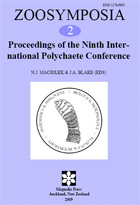Abstract
Reproductive crosses between geographically separated populations of the nominal species, Polydora cornuta, support the hypothesis that the Florida/ Gulf of Mexico populations represent a single, potentially interbreeding lineage that is reproductively isolated from West Coast (California) and East Coast (Carolinas to Maine) populations. Previous research has indicated that California populations are reproductively compatible with worms from North Carolina but reproductively isolated from Maine populations. In spite of these species-level differences, all populations of this nominal species deposit egg capsules inside the female’s tube that usually develop into three-chaetiger planktonic larvae measuring about 200 µm in length. Although adelphophagy (feeding upon unfertilized eggs within an egg capsule) has been reported in some populations of P. cornuta and in numerous other spionid polychaetes, the relationship between stored sperm in the female parent and the size of larvae within capsules has not been explored. We raised isolated female P. cornuta from three genetically and reproductively distinct populations (Florida, California and Maine) over a period of about 16 weeks and determined percent fertilization and larval size in successive spawnings over time until the females ran out of stored sperm. As each female used up stored sperm during successive spawnings, the percent of fertilized eggs per capsule declined and larval size at release increased. In some cases, the largest larvae produced by an isolated female were 114% larger than the smallest larvae produced by the same female. Larvae inside capsules containing unfertilized eggs fed upon these eggs and grew larger than larvae that did not have unfertilized eggs to feed upon. The effects of producing larger larvae following stored sperm depletion were completely reversed by transfer of fresh spermatophores to the isolated females. Variable larval size produced by a single female worm (poecilogony) may therefore be a result of stored sperm limitations rather than a genetically determined reproductive strategy in this species complex.

